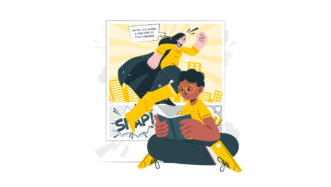LESSON OVERVIEW
In this ESL lesson about happiness, students talk about the feeling, watch a video and discuss happiness myths. The teacher can also choose to do an optional vocabulary activity with students.
C1 / Advanced45 min
60 minSpeaking ClassUnlimited Plan
This is a Speaking Class worksheet. It includes a variety of tasks that let your students practise their speaking skills. This lesson format does not focus on grammar or vocabulary. Learn more about it here.
WARM-UP & VIDEO
At the beginning of this ESL lesson about happiness, students look at three definitions of the word happiness and say why they think the definitions are so different. Then, students look at a list of nouns (e.g. bliss, contentment, wonder, euphoria) and choose four which they think give the best idea of what happiness is. Students also need to explain what the connection between the words and happiness is. The teacher can also choose to ask students to create adjectives from the nouns and/or think of verbs that collocate with the nouns. Before watching the video, students think of the things that are or were thought to bring happiness by various generations (e.g. your grandparents’ generation). Then, they watch the video and summarise their opinions about it in one sentence.
SPEAKING
In the second part of this ESL lesson about happiness, students say whether they agree that the ideas from the video are myths. They need to explain their opinions. Then, students look at some quotes from the video and discuss some questions. For example, they talk about checklists with life goals, how certain narratives can be motivating or demotivating or how we can be less judgemental about people who choose different life paths than us. In the final part of this ESL lesson about happiness, students say whether they agree with some statements about happiness. For instance, they talk about happiness being a journey, not a path, and happiness being a universal human pursuit. The statements are also a comment on sadness, self-acceptance and chasing happiness. In the task, students need to explain their answers.
Subscribe to unlock these and many other Standalone lesson lesson plans with the Unlimited planWORKSHEETS














Thank you, thank you, thank you! We has a blast. What a wonderful lesson with thought-out activities! Can we haver more of those, please?
Happy to hear the lesson was a success. And we will keep publishing 3 speaking classes every month 🙂
And where is the worksheet? I have subscribed but cannot see a worksheet for this lesson.
Hi Antonia! The worksheet is available in the Unlimited subscription. Please drop us a line at [email protected] if you have any questions.
rapped should be wrapped
rap is very different to wrap
Hi, thanks for spotting that! It’s now fixed.
Hello, thank you for this wonderful lesson plan. For my advanced students, during the 2-hour lesson, I decided to make it even more engaging by incorporating a role-play, perhaps someone would like to do it too. So, each student will present their arguments (using various linking phrases for argumentation) based on their assigned role and will need to convince the group that having money, or having a well-regarded career, having kids, or not having kids can bring happiness. This activity is well-suited for a smaller group of students, perhaps. The roles are as follows:
Millionaire’s POV
Careerist’s POV
A Happy Parent’s POV
The Independent Individual’s POV (single/no kids).
Thanks again for sharing great lesson plans.
Thanks for sharing!